Social and economic development. Рубрика в журнале - Economic and Social Changes: Facts, Trends, Forecast
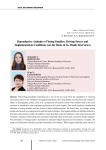
Статья научная
Promoting population reproduction is one of the key tasks from the standpoint of ensuring national security. In the conditions of aging motherhood, the young family becomes the most important object of demographic policy, since it is a prosperous two-parent family with children that is the main resource of quantitative and qualitative parameters of human capital. The article analyzes reproductive attitudes of young families and the drivers of their implementation. We reveal that, on average, young people are focused on creating a family and having few children. The registered failure to fulfill reproductive intentions (the desired number of children is more than their expected number) is due to the financial and economic situation of the family, the uncertainty (possible risks) of the future, and intra-family relations. The formation of young people's reproductive attitudes largely depends on their parents' example, the quality of child-parent relations and the immediate environment. With a high probability, those raised in a family with few children or those who have no siblings at all may not want to have many children or have children at all. As for children from medium and large families, they may have different views on having children. Reproductive attitudes are linked to marital ones. As a rule, the orientation toward a legitimate happy marriage is reinforced by the desire to have children. A variant of child-centered motives is observed in girls and manifested in the desire “to have a big family and many children”, which somewhat shifts the focus of the priority of intra-family relations. The importance of the housing issue and ensuring a decent standard of living for oneself and one's children is determined by the fact that the unresolved nature of these problems influences the intention to have the first child and reduces the chances of having a few and many children even if they are desirable. State support for young families is needed, despite differences in the estimates of its effectiveness. The difference lies in determining the most desirable mechanisms - it is either direct support in the form of allowances, benefits, etc., or the creation of conditions for raising children (affordable quality social infrastructure) and the possibility of decent earnings for parents. Today, a young family needs state support, and, undoubtedly, the needs of young families should be taken into account in the national demographic policy.
Бесплатно
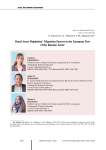
Rural areas population’ migration factors in the European part of the Russian Arctic
Статья научная
The study of migration remains relevant, despite the presence of a wide range of papers by authors from Russia and other countries on the subject. The features of migration processes, in particular migration factors, in rural areas of the Arctic zone of the Russian Federation are of the greatest interest due to the current accumulation of sufficient amount of data for analysis. The article considers seven municipalities of the European part of the Russian Arctic and empirically determines statistically significant migration factors through correlation analysis. Data on 15 indicators were collected from 2008 to 2021. We reveal that the most significant migration factors are the development of education, the situation regarding transport links, food and financial security of the population, and housing provision. At the same time, the combination of statistically significant factors is unique for each individual municipal entity. The thesis, widespread in the migration theory, about the greater influence of economic factors on the dynamics of migration was only partially confirmed in the case of the rural areas under consideration. It was found that individual indicators, such as agricultural production and employment, generally do not affect migration decline (increase), and the established relationship with such an indicator as wage level cannot be interpreted unambiguously. With the growth of labor incomes, the outflow of rural residents from their native areas reduces, but does not disappear completely. In turn, the increase in nominal wages is to a large extent a reflection of the inflationary effect; therefore, it cannot be an effective mechanism for retaining the rural population.
Бесплатно
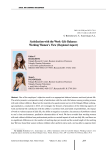
Satisfaction with the work-life balance: working women's view (regional aspect)
Статья научная
One of the employee’s objective needs is an appropriate balance between work and private life. The article presents a comparative study of satisfaction with the work-life balance among working women with and without children. Based on the materials of a questionnaire survey of the Vologda Oblast workingage population, conducted in 2018, we investigate the features of perception of the following aspects of work and family life: satisfaction with the ability to combine work and family responsibilities, the impact of work on various aspects of daily life, the ability to organize recreation, the presence of problems related to one’s close environment, qualitative characteristics of work. We have revealed that working women with and without children have predominant positive or neutral impact of work on daily life, and there are no significant differences in the number of working days per month and the actual length of the working day. We have found that women without children often perform extra work, are less able to organize their leisure time, and are harsher in relation to their close environment. However, there are no significant differences in satisfaction with the work-life balance among women with and without children. The paper determines that working women (regardless of parental status) who satisfactorily assess the ability to combine work and family responsibilities are characterized by better indicators of labor activity (fewer delays and disruptions in work, less failure to fulfill plans, etc.), a higher level of realization of physical, personal and professional abilities in work. The similarity of the subjective perception of the work-life balance among working women with and without children may indicate women’s high adaptability to multitasking and time allocation. We highlight the importance of improving the policy on family and employment, in particular in terms of developing flexible employment formats.
Бесплатно
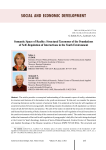
Статья научная
The article provides a conceptual understanding of the semantic space of reality, substantiates its structure and features of its formation in the youth environment. To this end, we consider the process of meaning formation and the content of semantic fields. It is analyzed as the basis for self-regulation of social interactions between young people. Identifying semantic foundations of self-regulation is a relevant research task for both theory and practice. The aim of the study is to identify the structure of relationships and hierarchical clustering of basic elements in the mechanism for self-regulation of social interactions in the youth environment with the help of the structural and taxonomic model. The model was constructed within the framework of the tool for self-regulation of young people's daily life; the tool is being developed at the Center for Youth Sociology, Institute of Socio-Political Research, Federal Center of Theoretical and Applied Sociology of the Russian Academy of Sciences (ISPR FCTAS RAS). The structural and taxonomic approach allows us to obtain structural-taxonomic maps that display multi-layered structures of relationships within the mechanism of self-regulation, as well as connections between different meanings that are reproduced and constructed in the youth environment in the process of everyday interactions. In contrast to the automatic classification as the classical task of taxonomy, the structural and taxonomic approach focuses on identifying the structure of the most significant relationships between the objects being classified; such objects (which are considered in the present paper) are the elements of self-regulation mechanism in the life of young people. We design a structural and taxonomic model using the data of a sociological survey; this allows us to offer reasonable descriptions and explanatory interpretations of the results. The analysis is based on the findings of empirical studies we obtained in the course of a survey of Russian youth 15-29 years of age. We use taxonomic analysis to reveal the structure of the semantic space of young people. We conclude that semantic connections within and between semantic fields are ambiguous. Having implemented structural and taxonomic modeling of the semantic space, we identify several levels of semantic fields. Their analysis allows us to form an idea of the semantic foundations of self-regulation of young people's interactions with each other and with society.
Бесплатно
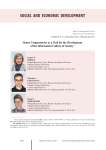
Smart competencies as a tool for the development of the information culture of society
Статья научная
The article considers the process of formation of smart competencies, which have a synergistic nature, as a tool for creating samples of the information society culture. The purpose of the study is to assess the effectiveness of smart competencies formation in a managed (institutionalized) and unmanaged (non-institutionalized) environment. The paper presents a conceptual understanding of smart competencies as the integration of modern basic and flexible skills in the educational profile of a student. We provide the results of a modeling experiment conducted in 2020-2021. The experiment consisted of the identifying, forming, and resulting stage. Seventy-six schoolchildren from Vologda and Staraya Russa participated in each stage. The participants were divided into a control group and experimental groups. In the framework of the experiment, in accordance with the principles proposed in the study, two measurements of smart competencies (initial and control level) were carried out. In the interval between the measurements, a stable level of smart competencies was maintained in the participants. The results of the experiment have revealed considerable opportunities for the formation of smart competencies in a controlled environment in conventional educational conditions. It was in this case that the strategic level of competence development was preserved during the experiment (which was not observed in other groups). In conclusion, we determine which types of information culture are created by smart education. The novelty of the project consists in the proposed original model for the study of smart competencies, which defines the structure and features of this phenomenon. Within the framework of the study, we propose a methodological approach to organizing the process of development of modern competencies in the smart environment, which can be used by educational organizations in Russian regions.
Бесплатно
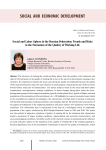
Статья научная
The relevance of studying the social and labor sphere from the position of its tendencies and risks for the formation of the quality of working life is due to the search of determinants causing its low estimates. It is important to address the issues concerning the quality of working life because the quality of life in general becomes today the main criterion of social progress, indicating the turn of the economy toward human needs and its humanization. The article analyzes trends in the social and labor sphere (employment, unemployment, working conditions). It shows changes taking place inside the sociodemographic groups of the employed population (growth of educational level, growth of highly educated population in the composition of the unemployed, etc.). We highlight the causes of economic losses related to the unsatisfactory condition of workplaces, the maintenance of a high share of workers in industries with harmful and hazardous working conditions, and workplace injuries. We provide index assessments of the quality of working life of the employed population and assess workers’ low satisfaction with working conditions. The information base is represented by the data of a sociological survey of employable population of the region, conducted by RAS Vologda Research Center in 2018 and 2020. The article uses the method of subjective evaluation of quality of working life by the indicators that characterize people’s assessment of wages, working conditions, organizational and economic characteristics, and socio-psychological conditions. Scientific novelty of the research consists in substantiating the influence of social and labor sphere on the formation of the quality of working life of the working population. Practical significance lies in the development of proposals to improve the quality of working life, which helps to obtain positive results in terms of improving the efficiency of working activity. Various social innovations (organizational, environmental, aesthetic, etc.) in the workplace that influence employees’ work efficiency (for example, the introduction of health saving programs at enterprises and organizations, which will reduce losses from disability) can be such tools. They can also include surveys of employees about their satisfaction with the quality of working life in a special assessment of working conditions.
Бесплатно

Social capital of the Russian region: state and dynamics
Статья научная
Social capital is the basic characteristic of the system of social relations arising in a territorial community. In the context of ongoing global transformations, manifested both on a national scale and at the regional level, there is a need to analyze the changing social reality. We consider the concept of social capital as a promising explanatory model in the analysis of ongoing social changes. Based on this theoretical approach, the goal was set to analyze the state and dynamics of the social capital of the territorial community. The object of the study is the territorial community of the Vologda Oblast, the subject is the state and dynamics of social capital. The novelty of the work consists in obtaining analytical data by conducting a unique long-term observation, which has become, in fact, monitoring. The study used the author’s methodology for determining the level of accumulated social capital based on its integral index calculated for each respondent, which allows us to identify groups of its carriers characterized by different amounts of social resources that can serve as a factor of noneconomic development. The empirical basis of the study is the results of public opinion polls conducted in 2016, 2019, 2020 and 2021 among the population of the Vologda Oblast on a multi-stage, quota-based settlement and demographic characteristics, a random sample at the stage of selecting respondents. In the course of the study, fairly stable groups were identified that maintain their boundaries throughout the observation period. The changes in the social capital index recorded during the observation period serve as an indicator of its dynamism. The influence of environmental factors, for example, the pandemic, which affected the loss of social capital, was revealed. The analysis showed that various local communities differed both in the volume of losses and in the ability to restore social ties. The least losses and faster recovery were observed in rural areas. The results of the study can be used in the activities of federal, regional public authorities, local governments, scientific and educational organizations in the analysis of social processes in regional territorial communities, as well as serve as a basis for further research on the subject under consideration.
Бесплатно
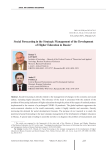
Social forecasting in the strategic management of the development of higher education in Russia
Статья научная
Social forecasting is directly related to the management of changes in the economy and social sphere, including higher education. The relevance of the study is associated with the analysis of the problem of forecasting indicators of higher education through the prism of the targets of national projects implemented in the context of a prolonged COVID-19 pandemic. The global epidemic aggravates the socio-economic situation in the world community, makes it highly instable and uncertain, thereby increasing the demand for social development forecasts. The purpose of our research is to study the potential of social forecasting in the state strategic management of the development of higher education in Russia. A special task revealing its scientific novelty is to diagnose the problem of measurement and profiling the methodology of reproduction of the “strategic intelligentsia” (elite) as a “transformative” subjectivity. In the study, we rely on the theory of the socio-cultural management model put forward by Professor A.V. Tikhonov, as well as on the authors socioprognostic approach to management, which acts as a special methodological means of scientific search, integrating ideas and theoretical constructs in the field of social sciences and humanities, while substantiating the solutions to promising problems with the use of modern project-based technologies. With the help of these tools, we profile the multivariate levels of scientific foresight and strategic management, analyze the forecasting and regulatory actions of the Ministry of Science and Higher Education of the Russian Federation as a macroregulator of the functioning and development of higher education, and identify key components in reformatting and optimizing social forecasting in the state strategic management of higher education development. The work is based on the perspective practice of research of manageability of regional development and social group formation, which is in demand by the academic community, acquired by scientists of the Center for Sociology of Management and Social Technologies of the Institute Sociology - Branch of the Federal Center of Theoretical and Applied Sociology of the Russian Academy of Sciences in 2015-2020, including that achieved in the study of higher education as a resource for managing the socio-cultural modernization of regions. The materials of the article have theoretical and practical significance; they are intended for specialists in the field of state, regional and municipal management, as well as experts in social forecasting and strategic management of the development of higher education in Russia.
Бесплатно
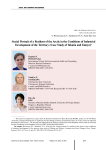
Статья научная
The way of life of the indigenous and incoming population of the Arctic zone of the Russian Federation requires a detailed study, since it is in these areas that the exploration and extraction of minerals for the purpose of territorial industrial development has been actively carried out in recent decades. The article reveals the social portrait of residents of Russia's Arctic regions, who are immediate participants in the changes taking place in the territories of their residence and associated with the implementation of large-scale mining projects. We conducted the empirical part of the study in 2017-2020 in the Republic of Sakha (Yakutia), where placer gold and diamonds are currently explored and mined, and in the Taimyr Dolgano-Nenets Municipal District of Krasnoyarsk Krai. The object of the study was the economic behavior of local residents of the Arctic regions; the subject was their attitude toward the activities of mining companies. As a result of a sociological survey in the form of questionnaires (cluster sample, 859 people, age selection from 18 years and older), informal conversations with local residents, we gave their socio-demographic characteristics, presented their attitude toward traditional trades and crafts and toward the industrial development of Russia's Arctic regions. The practical significance of the study consists in analyzing modern characteristics of an Arctic resident; this analysis can be of use to various stakeholders involved in the implementation of state programs for the development of Russia's Arctic territories. The study of the problems and needs of indigenous peoples of the Arctic zone of Russia allows avoiding resource conflicts between state structures, industrial companies and the local population.
Бесплатно
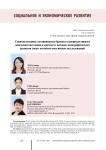
Статья научная
The growth of the quality of human potential is an important component of the “great rejuvenation of the Chinese nation” (Chinese dream) and a key goal of Russia’s socio-economic development, and birth rate is a fundamental factor affecting the long-term demographic trends of both countries. In a report at the XX National Congress of the Communist Party of China, it was proposed to “optimize the population development strategy, create a policy system to support family planning and reduce family costs for childbearing, upbringing and education of children; these areas are highlighted as the main postulates in the concept of building a “Healthy China”. In Russia, the importance of preserving people, caring for the family, and strengthening traditional values is also recognized at the highest level. Support for the family, motherhood and childhood, and an increase in birth rate are defined in the National Security Strategy of the Russian Federation. Presidential Decree 809, dated November 9, 2022, approved the key staples of Russian culture, including the family with children based on love and marriage. The aim of the work is to substantiate the need to strengthen the information and educational component of demographic policy regulating marital and family relations. We conducted a study using the methods of literature review, analysis of statistical data on the demographic development of provinces of Central China and federal districts of the Russian Federation, and also using the results of questionnaire surveys of Jiangxi Province and Vologda Oblast population. It was revealed that birth rate is low in almost all macro-regions of China and Russia; the number of women of reproductive age is decreasing; reproductive behavior is characterized by a focus on childlessness, marital behavior is characterized by postponement of marriage, blurring of social norms (traditions) of marriage. The decrease in birth rate occurs against the background of population aging, ensuring a further increase in the proportion of older people. The formation of a new “culture of marriage and childbearing” is a long-term project that will contribute to changing marital behavior and will require promoting family planning policy and strengthening state support in this area, forming a harmonious and friendly social environment, promoting ideas of strong marriage and childbearing.
Бесплатно
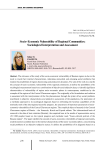
Socio-economic vulnerability of regional communities: sociological interpretation and assessment
Статья научная
The relevance of the study of the socio-economic vulnerability of Russian regions is due to the need to reveal their internal characteristics, indicating unresolved and emerging social problems that weaken the possibilities of regions functioning and productive dynamics. The aim of the work is to clarify the concept of socio-economic vulnerability of the regional community; to define the possibilities of its sociological measurement based on a combination of objective and subjective data; to identify significant characteristics of vulnerability of region socio-economic sphere in contemporary conditions by the example of the regions of the Central Chernozem region. The originality of its formulation and solution is associated with the interpretation of the this phenomenon through the prism of key social problems manifested in objective characteristics and subjective assessments of the population, the promotion of a methodic approach to its sociological diagnosis based on rethinking the heuristic capabilities of the methodic tools of the interregional scientific program, the assessment of important parameters of socio economic vulnerability of the Central Chernozem regions. The empirical object of research is the Central Chernozem regions of Russia - the Voronezh, Kursk and Lipetsk oblasts. The informational basis of research is the data of state statistics (Rosstat); the empirical base is the results of representative survey (N=1200 people) based on the typical program and methodic tools “Socio-cultural portrait of the Russian region”. The paper clarifies the concept of socio-economic vulnerability of regional community, understood as its condition due to the internal characteristics of the socio-economic sphere, concentrating social problems of an objective-subjective nature. It defines the possibilities of its diagnosis based on a combination of measuring objective facts and subjective assessments on a number of indicators of the typical methodic. It reveals the key vulnerabilities of the socio-economic sphere of the central chernozem regions in contemporary conditions: the prevalence of poverty and a high degree of socio-economic differentiation of the population in a subjective measurement; the downward short-term dynamics of the material status of a population significant part. The results expand the scientific understanding of the socio-economic vulnerability of regional communities and can be used to define their social problems of objective and subjective nature and to find ways to solve them.
Бесплатно

Статья научная
The relevance of the research is due to the fact that the phenomenon of reintegration of migrants returning from Russia to Kyrgyzstan has not been sufficiently studied. Little research has been done on the problems migrants face when reintegrating into the society of their country of origin; such problems include, for example, economic and social situation, the socio-psychological well-being ofmigrants and the level of reintegration. The aim of the study is sociological assessment of the sustainability of reintegration of migrants returning from Russia to Kyrgyzstan. Scientific novelty consists in the concretization of the term “reintegration” as a multidimensional process that allows migrants to restore the economic, social and psychosocial relationships necessary to move forward in life; and the term “sustainable reintegration”, as the returnees achieve a certain level of economic self-sufficiency, social stability and psychosocial weh-being; in the development of empirical indicators of sustainable reintegration, such as the ability of a returned migrant to provide for themselves and their family, participate in economic activities, housing, build strong social relationships and be involved in the local community, psychological well-being, the ability to use basic services, and the absence of migration plans after return. We provide a sociological assessment of the sustainability of reintegration of migrants returning from Russia to Kyrgyzstan, based on the results of a questionnaire survey of 515 return migrants, and focus group interviews with 37 return migrants in Kyrgyzstan in October - November 2022. It has been revealed that the reintegration of return migrants from Russia to Kyrgyzstan is quite sustainable in all spheres: economic, social and sociopsychological. At the same time, the returnees have certain problems reflected in the insufficiently high level ofjustification of expectations from the return and in possible intentions to migrate again to Russia or other countries.
Бесплатно
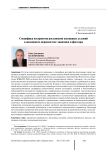
Specifics of Russians’ perception of housing conditions and housing inequality: dynamics and factors
Статья научная
The paper analyzes the dynamics and specifics of Russians’ perception of their housing conditions, housing inequality, as well as assessments of the overall housing situation in the country. Based on the data of all-Russian representative studies conducted by the Institute of Sociology FCTAS RAS using face-to-face method in the framework of door-to-door surveys, it is shown that for most Russians housing inequality today is more related to the problem of housing quantity and quality, rather than housing availability. In this regard, housing inequality remains a critical issue, and its severity varies for different groups. Key factors determining the specifics of subjective assessments of housing conditions and the acuteness of housing inequality in modern conditions are the stage of a person’s life and their resource base, which includes not only income, but also intangible characteristics related to employment, education and the number of problems an individual has to deal with. It is shown that the greatest match between housing conditions and related subjective demands is recorded in the most prosperous groups, and the greatest mismatch, respectively, in relatively disadvantaged ones. Attention is focused on a very limited list of tools used by Russians to improve housing conditions, the most common of which is the purchase of housing, and the high relevance of settlement inequalities in this context. Although most Russians approve of the state housing policy, it is highly focused on addressing housing issues, but does not fully take into account inequality in the quality of housing conditions.
Бесплатно
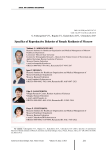
Specifics of reproductive behavior of female residents of Moscow
Статья научная
Birth rate dynamics in Russia’s population remains one of the major objects of attention of demographic science and politics. In 2019, the aggregate birth rate in Moscow exceeded the Russian average, giving rise to assumptions about the likelihood of the emergence of a new trend, despite the fact that studies of reproductive behavior of city dwellers indicate the prevalence of intentions to have fewer children. The article presents estimates of birth rates in metropolitan megacities of Russia, indicating that the values of indicators are still lower than the Russian average and even lower than the same indicators for Russia’s urban population. According to the data of an up-to-date survey of female Moscow residents, we find the prevalence of intentions to have fewer children and postpone childbirth. Significant factors influencing the intentions of female Moscow residents to have children are marital behavior, level of education, standard of living and value orientations. Birth rates in female Moscow residents with higher education in real generations are slightly lower than the Russian average. A slightly less pronounced inclination toward getting married in a civil ceremony also has a significant determinant role. The impact of income level cannot be assessed unambiguously. Indeed, in groups of women with relatively lower welfare, fertility rates are higher, but this is due to the ratio of satisfaction with the standard of living and the importance of children (the need for children). A higher level of income (and satisfaction with it) contributes to the realization of reproductive intentions. Female Moscow residents tend to have fewer children since such an attitude is passed down from previous generations; besides, among them, there is a higher proportion of those focused on individual values, which also determines a lower birth rate in a metropolitan megacity. Taking into account birth rate trends and the peculiarities of reproductive behavior of female Moscow residents can contribute to improving the effectiveness of demographic policy.
Бесплатно
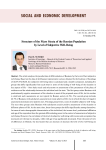
Structure of the mass strata of the Russian population by level of subjective well-being
Статья научная
The article analyses the peculiarities of differentiation of Russians by the level of their subjective well-being. Based on the data of all-Russian representative surveys obtained by the Institute of Sociology of the FCTAS RAS, the subjective well-being index is calculated and a model is proposed, including five groups that differ significantly from each other in terms of the feeling of well-being of the situation in key aspects of life – from basic needs and microcosm to assessments of the parameters of the place of residence and the relationship between the individual and the state. The first group unites Russians with predominantly negative assessments of the situation in most of the proposed areas of life, but its number is small and such assessments are not typical for Russian society (4.3%). The second group includes 46.7% of Russians with satisfactory assessments in most spheres of life, but in which the share of negative assessments dominates over positive ones. This large group forms a zone of unstable subjective well-being. The next three groups unite Russians with satisfactory and/or positive assessments of the situation in different spheres of life. At the same time, these three groups also differ significantly among themselves. In terms of socio-demographic characteristics of the individual, the income level, professional affiliation and age of the respondent have the greatest differentiating power in the context of assessments of subjective well-being. However, the correlation of the level of subjective well-being with income and occupation has increased over the last two decades, while with age it has significantly decreased. From the point of view of differences in lifestyle, the key factors that can increase or decrease the level of own well-being are both a set of property characteristics and a list of achieved life goals, as well as the specifics of experienced problems, perception of the dynamics of the situation in society as a whole and the ability to plan one's own life
Бесплатно
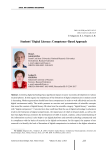
Students’ digital literacy: competence-based approach
Статья научная
Currently, digital technology has a significant impact on socio-economic development in various societal spheres. In this regard, the importance of the formation of digital competencies in student youth is increasing. Modern generation should have these competences in order to work effectively and use the digital environment safely. The article presents an overview and systematization of scientific concepts that reveal the content of digital literacy. We show how the scientific category “digital literacy” correlates with “digital competence”. Concrete facts have confirmed that the use of digital technology in education involves the formation of digital competencies, the importance of which is beyond doubt, as well as the fact that digital literacy promotes the development of skills in search, analysis, critical understanding of the information received; it also helps to use digital platforms and network technology competently and in compliance with the basics of security in the digital environment. In this regard, the purpose of our research is to identify the level of formation of digital competencies in students in the higher education system (on the example of the Chelyabinsk Oblast). Scientific novelty of the work lies in theoretical substantiation of the content of digital literacy and systematization of approaches using a competencebased approach. In this context, the results of a survey of students of four universities in Chelyabinsk, aimed at identifying regional features and problems of the formation of digital competencies in the higher education system, are of interest. The findings of our research can become an important methodological tool in determining risk groups by the level of formation of digital competencies in students, developing methods for the safe use of digital content, preventing the spread of destructive online practices among young people and promoting their safe use of digital content.
Бесплатно
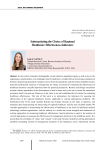
Substantiating the choice of regional healthcare effectiveness indicators
Статья научная
In the context of modern demographic trends related to population aging, as well as due to the ongoing pro-natalist policy, new challenges arise for healthcare, coupled with an increasing contradiction between the growing demand for medical services from the population and the limited available human, material and financial resources. Consequently, the choice of criteria for evaluating the effectiveness of healthcare becomes crucially important from the practical perspective. Russian and foreign researchers propose various approaches to the development of such criteria and to the way in which the assessment procedure itself is carried out. However, so far, there is no well-established list of criteria for evaluating healthcare effectiveness. The aim of this work is to substantiate the indicators for assessing the effectiveness of the regional healthcare system, applicable to solving optimization problems. The information base of the study includes Russian and foreign research on the topic in question, and statistical data characterizing the functioning of regional healthcare and the state of public health. We consider approaches to determining the effectiveness of healthcare at the levels of individual medical technology, medical organization, and the industry as a whole and reveal strengths and weaknesses of existing approaches to measuring healthcare effectiveness. Special attention is paid to the analysis of current approaches to assessing the effectiveness of management decisions in the healthcare sector. It is proved that the correlation of “input” and “output” is the most relevant method for solving optimization problems simulating variants of management decisions in the healthcare sector. Theoretical novelty of our research lies in substantiating a number of indicators for assessing the effectiveness of regional healthcare. Based on the analysis of data from Russian and foreign studies, as well as taking into account the correlation analysis, we propose to consider life expectancy at birth, mortality of the population over the working age, mortality from diseases of the circulatory system and one-year mortality of patients with malignant neoplasms as the resulting indicators of the functioning of regional healthcare. In the future, these indicators will be used as target parameters for solving optimization problems in the field of regional healthcare using its agent-based model. The proposed approach to assessing the effectiveness of regional healthcare can serve as a theoretical basis for an automated management decision support system in this area, which determines the practical significance of the research findings.
Бесплатно
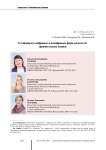
Sustainability of digital and non-digital forms of employment: comparative assessments
Статья научная
Modern theoretical and practical views on the impact of digitalization on welfare and quality of working life are controversial and fragmentary. The effectiveness of the application of digital social and labor relations is considered in scientific publications, as a rule, outside the context of sustainability. The aim of the work is to identify differences between digital and non-digital employment according to the criteria of sustainability in the context of standard and non-standard forms of social and labor relations. Key tasks are to develop our own methodology for assessing the sustainability of employment forms; carry out comparative and rating assessment of the sustainability of digital and non-digital forms of employment based on objective and subjective indicators. Empirical basis includes the results of a nationwide survey of able-bodied population aged 20 to 59, N = 2,896 people, quota sample. Key controlled features are sex and type of residence area (region’s administrative center, city, rural settlement). All federal districts are covered with the exception of the Southern Federal District. We reveal that, according to most indicators, digital standard and non-standard forms of employment are more stable than non-digital forms, they occupy 1st and 2nd places in the final ranking. Digital standard employment is inferior to non-digital standard employment only in terms of the ratio of labor income to subsistence minimum. According to other objective indicators, digital employment demonstrates either significantly better working conditions or comparable social effectiveness. Digital non-standard employment is significantly more sustainable than non-digital non-standard employment in terms of the ratio of labor income to subsistence minimum, probability of a normal working week and possibility of voluntary choice of afterhours. The non-digital format is more stable in terms of legitimacy of labor relations and possibility of voluntary choice of underemployment. Subjective assessments of the effectiveness of employment formats among respondents in the digital segment are higher in all indicators of sustainability, especially in terms of job satisfaction and financial situation. A promising direction for future research les in conducting expert assessments of the significance of the proposed indicators for the development of an integrated index methodology for assessing employment sustainability.
Бесплатно
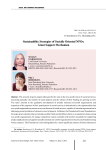
Sustainability strategies of socially oriented NPOs: grant support mechanism
Статья научная
The amount of grant support allocated by the state to the non-profit sector of social services is increasing annually; the number of social projects and the volume of their funding are growing as well. The state’s interest in the qualitative development of socially oriented non-profit organizations and expansion of the segment of their participation in social services is determined by the opportunities that non-profit organizations possess as new performers of social services, capable of introducing innovation in addressing social problems of citizens in need of support. In Russia, the Presidential Grants Foundation is the major grant operator that accumulates public funds and distributes them on a competitive basis among non-profit organizations. Its unique competitive system complies with modern standards for supporting project applications and supports socially oriented non-profit organizations in the process of implementing winner projects. The Foundation is also distinguished by a more significant amount of funds allocated to support grants in comparison with other grantmakers, including private foundations. The problem that determined the focus of the issues considered in the article is the contradiction between the significant amount of support provided to regional socially oriented non-profit organizations in the process of their formation as providers of social services, and the continuing low efficiency of these organizations. We investigate major strategies for raising funds by socially oriented non-profit organizations and show that their income portfolio consists mainly of the funding that comes from grant support, which is accompanied by risks of financial instability of organizations and an increasing dependence on grant funds as the main source of income. The empirical base of the study includes open source data and interviews with representatives of regional socially oriented non-profit organizations, resource centers and grantgivers (n = 27). Based on the analysis of interviews with the participants of the study, the article examines the possibilities of income diversification for non-profit organizations and the risks each strategic perspective may entail. We reveal the readiness of non-profit organizations to develop strategies aimed at attracting donor funding and income-generating activities. We also define conditions under which organizations are able to implement the discussed strategies in practice.
Бесплатно
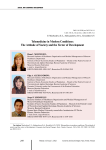
Telemedicine in modern conditions: the attitude of society and the vector of development
Статья научная
The intensive development of information technology and the external challenges, primarily the coronavirus pandemic, have caused a revision of attitudes toward telemedicine. The article is devoted to the study of problems concerning the development of Russian telemedicine, analysis of existing trends and the possibilities of its application, taking into account the development of communication technology and the legal field. Research on this issue is connected, on the one hand, with analyzing modern capabilities of telemedicine technologies and the need for their application in connection with the complex epidemiological situation in a number of Russia’s regions, on the other hand, with the assessment of the level of trust in telemedicine on the part of end users: who, how, when and where can use telemedicine services. The object of our research is telemedicine technology, the subject is the dynamics of perception of new forms of medical services by Russian society. We use a classical approach to studying the problems under consideration: at the first stage, we conduct a comprehensive desk study and analyze secondary information; at the second stage, we collect primary data: on the basis of the developed tools, we conduct an exploratory study of the attitude of Russian society toward telemedicine. The uniqueness and novelty of our findings are due to the comparison of the data concerning the attitude of Russians toward telemedicine, obtained before the outbreak of the pandemic, with the data obtained at the stage of a significant reduction in the incidence of COVID-19 in regions that have become “pilot” ones in the use of telemedicine technologies in primary care in the midst of the epidemic. During data collection and analysis, we applied statistical, mathematical and sociological methods, including content analysis to study legal issues of the possibility of using telemedicine technologies. The study has revealed the main reasons for Russians’ distrust of telemedicine, as well as possible ways and areas of its application in the future to provide medical care to the population. The results obtained can be used to study the application of telemedicine in Russia in the system of training and retraining of medical personnel, as well as by health care organizers, lawyers and other specialists who deal with the application of telemedicine technologies, including at the level of legislative and executive authorities.
Бесплатно

